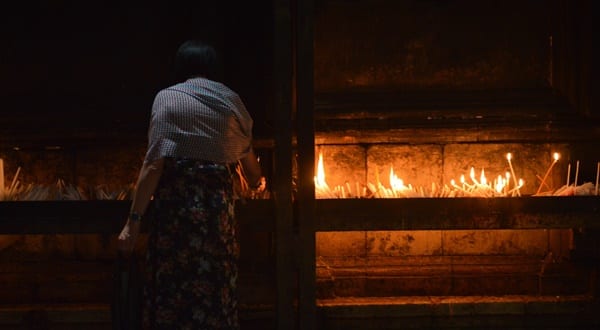During Lent we are inviting curriculum writers to tell us how their curriculum for children and youth deals with the violence at the Cross. We are delighted to open the series with a contribution from Catherine Maresca because her works shifts our normal approach to curriculum design. If you are like me, you start with a theological idea or interpretation of a text and design your class around that starting point. Catherine takes the opposite approach: she allows young children to offer their interpretation and theology to her. As the children respond to a biblical story in art, word or action, a theology emerges that provides spiritual nourishment and often a radical reimagining of the story for grown-ups. This is one reason that Catherine calls the responses of the children “gifts”. It is our pleasure to introduce you to Catherine and her work as founder and director for The Center for Children and Theology where you will find a rich trove of resources for use in your classrooms. You can read more about Catherine and the CCT at the end of the article. Catherine will be presenting at Faith Forward, a gathering of people engaged in children and youth ministry, April 20 – 23 in Chicago. Suzanne and Adam are presenting a workshop, too. Maybe we will see you there!
THE CROSS: A SIGN OF HOPE AND LIFE
by Catherine Maresca
In all four Gospels the progression from Crucifixion to Resurrection is immediate. Jesus dies, he is buried, and then the passage announcing the resurrection begins. The transition phrase in Matthew and John is that “Jesus expired,” in Mark and Luke that Jesus “breathed his last”.
There are several Greek words for “breath” and “spirit”, but one that means both breath and spirit is pneuma. And at this moment of passage from death into risen life the word pneuma hints at the interplay between expiring/dying and breathing new life and spirit into the world, and into each of us. The wind of the Holy Spirit in Acts 2, and Jesus breathing on the disciples and saying “Receive the Holy Spirit” in John 20 strengthen the connection between the life and breath and the spirit of Jesus, given to us from the cross.
In my office I have a beautiful gift of about 180 original drawings of the cross from the students at Christian Family Montessori School, where I have been a catechist for 30 years. They are full of color, nature, intricate designs, and symbols of our faith. They are full of joy.
In contrast, the most common images of and language about the cross in many of our churches today are grim depictions of the crucifixion, phrases like “Jesus died for our sins”, and complete disconnection from the resurrection. These are images that the students of CFMS have often been exposed to, and phrases they have heard at home or at church. Yet they are not the images that emerge from their hearts after years of taking in and reflecting on the death and resurrection of Christ.
As three-year-old children in the atrium, they are introduced to the cross at a model altar. Paten and chalice, crucifix and candles are all placed on the small cloth covered table. But this crucifix does not have the suffering, dying Jesus on its face. Instead there is an image of the risen Lord. The San Damiano cross, crosses from El Salvador and others are available that depict Jesus alive, dressed, and arms outstretched in blessing and welcome. He is risen!
When we present the Last Supper, the words of Jesus over the bread and wine are repeated, followed by a simple narrative: “the next day Jesus died on the cross (a traditional crucifix is placed on the small table), and on the third day Jesus rose (two candles are placed on the table and lit), and he remains with us always in the bread and in the wine.”
In these and other materials, the 3-6-year-old children hear again and again the simple announcement that Jesus died and is risen. We always tie together the death and resurrection of Christ when we speak of them. No explanation is given and no blame assigned. The children receive the announcement with simple faith and love.
The 6-9-year-old children bring their developing reasoning and moral concerns to the announcement. They do not doubt, but there are important questions to be explored. If Jesus is so good, why would anyone want to kill him? If Jesus is God, how is it possible for him to die? For these children the parables of the Good Shepherd and the Grain of Wheat from the Gospel of John are presented to help them explore these questions.
We also have a collection of crosses from various countries and times that can be traced. Most of these pair the shape of the cross with another symbol, such as a circle to proclaim God’s eternal life. Some have flowers or intricate designs to proclaim new life. Some have three lines together to indicate the Trinity. Again, explanations are not offered, but as the children trace and color these crosses again and again they consider the mystery of the death and resurrection of Christ.
And now we have this beautiful array of crosses drawn by children ages 7-12 to consider. It is striking to see both what is not included and the symbols and colors paired with the cross in these images.
There is no blood, no sign of suffering, and no tears.
Of 188 crosses:
35 are abstract designs
34 are rainbow colored
29 are linked to abstract concepts such as peace, love, beauty, grace, caring, elegance, sympathy knowledge, and joy
12 are linked to plant life
9 include hearts
9 are linked to water
7 are linked to animal life
7 are linked to light
5 are linked to fire
5 are linked to eternal life or heaven
5 include circles
4 are linked to the elements
1 each is linked to sound, earth, time and Eucharist.
So we have children who have absorbed the language and images of the cross as a sign of death and resurrection, and also the language and images of the cross as a sign of suffering and death. But when we look at this art that comes from them we see that they are affirming the cross as a sign of resurrection – life in all its forms, water and light and color and shapes and all that is good.
In addition to this book of crosses one other day stands out in my mind when I consider children and the cross. There was a day when a mother of a child in the school died of cancer. She was well known to many of the children in our class of 6-9 year olds. During the morning after her death children came into the atrium one or two at a time and sat down with paper and drew page after page of very plain crosses. No body, no color, no extra shapes or details. Just brown crosses. The children said very little, but I saw in their crosses an acknowledgement that the passage into new life includes death, and the first hours of facing death are very stark. But the cross also was a source of comfort as they waited for the grace of resurrection to break in.
What are the implications of the children’s art for our approach to the cross with them (and each other)? At the heart of the good news of Christianity is the gift of the life of Jesus flowing into the resurrection. The cross cannot be a symbol of Christianity if it is not a sign of his death and resurrection as one event. Adults are more conscious of life’s challenges and suffering, and the aspect of the cross they connect to may be the suffering and death of Jesus. But children see the cross and connect it to the resurrection. Jesus is alive and within us, as well as in nature, one another, the Word, the bread and wine of Eucharist. These children can gently and joyfully draw all of us into the good news of the resurrection that follows suffering or death.
We can let go of the phrases about suffering, death, guilt, sin and atonement and speak simply of death and resurrection. We can set aside the crucifixes and use instead the jeweled or plain crosses of our tradition. We can offer the parables of the Good Shepherd and the Grain of Wheat to explore the meaning of Jesus’ death instead of dogmatic and incomprehensible sentences.
And as we approach death and violence in key passages of the Hebrew Scriptures, we can let all we know of God’s Kingdom and God’s way of life inform our reading and reflection. We can let all we have learned of God in the thousands of years since these texts were written be our lens as we read, seeing hints of God who we have come to understand with the help of the prophets, the sages, and holy people everywhere.
About Catherine Maresca
“The Cross, a Sign of Life and Hope” is a chapter of Maresca’s upcoming book, Good News and Violence.
Since the 1980’s Catherine Maresca, MA, has been a catechist and conducted formation courses for catechists across the United States and in Uganda. She is founder and director of the Center for Children and Theology, where she researches the spiritual life of young children, author of DoubleClose, the Young Child’s Knowledge of God.
The Catechesis of the Good Shepherd is a Montessori-based approach to the religious formation of children, rooted in Sacred Scripture, liturgy, and respect for the child’s rich relationship with God. Central to CGS is the atrium, a room containing beautiful materials that focus the child’s attention on key scripture passages or liturgical moments.
After an introduction by the catechist, the children are invited to work with a material on their own to continue their meditation. Because children learn by using their hands, working with materials allows them to enter more deeply into meditation, nurturing their relationship with God.
Beginning their work in 1954, Dr. Sofia Cavalleti and her co-worker, Gianna Gobbi, developed the catechesis by observing and working with children between the ages of three and twelve. It is the joyful, peaceful response of the children themselves that inspired and determined the content of this unique program.











